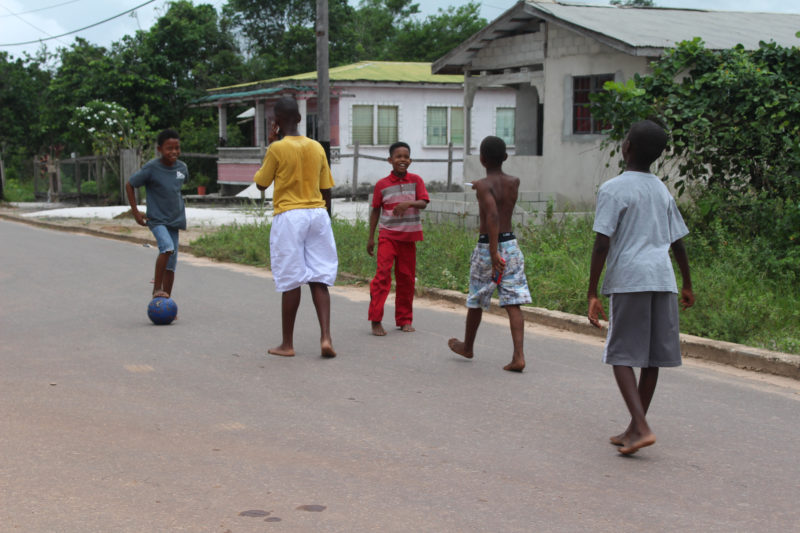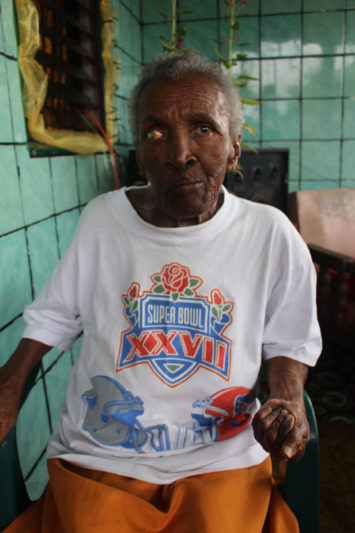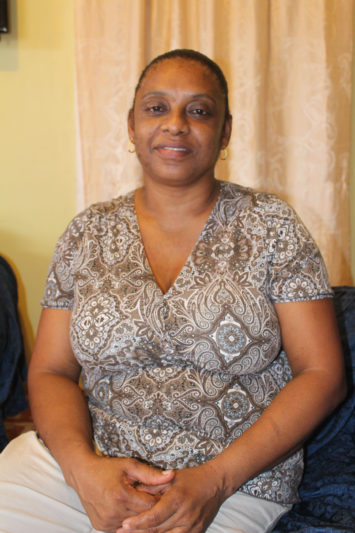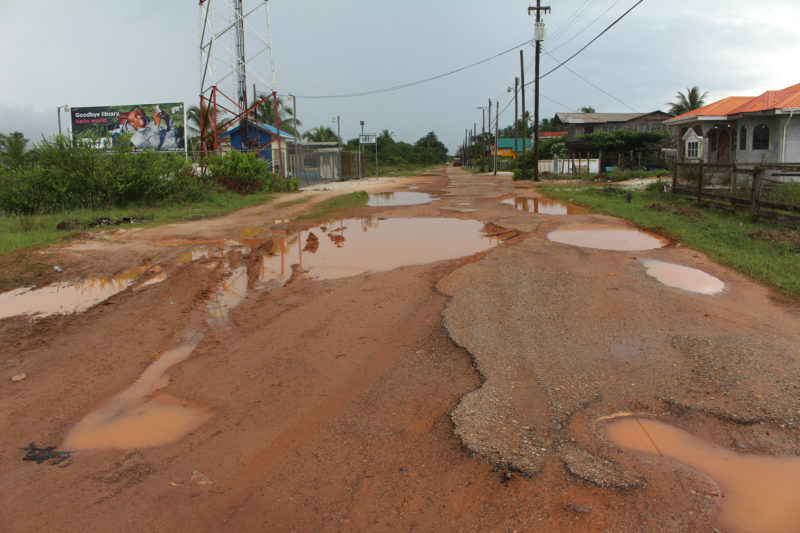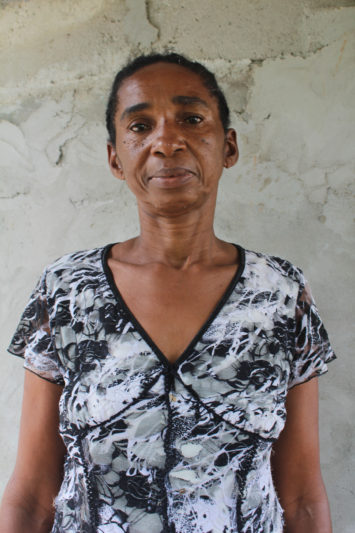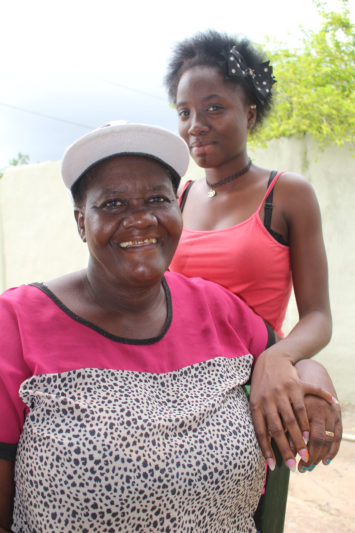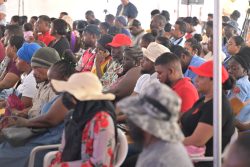Central Amelia’s Ward is a quiet village in Linden. It is well laid out because it was built as a housing community and was never subject to squatting. A few persons had gathered together chatting, a couple of men were fixing a truck and others had congregated in front of a wash bay looking on. Some younger men played football in the street, while a few girls observed. A police patrol rolled by on an ATV, yet the village had a strange quiet.
At the head of the village, standing on one of the streets running parallel to the Linden-Soesdyke Highway, one would notice the road leads down a slope. Barely a quarter of the way down, I caught up with Elize Kingston who was cutting up vegetables to prepare lunch.
Kingston, who lived most of her life in Wismar moved with her family after being allotted a piece of land in 2003. She welcomed moving into Central Amelia’s Ward as it was higher up and wasn’t prone to flooding like the street she had left behind which she said flooded easily from the rain or the high tides.
But she does have another issue to deal with when the rains come. The street situated in front of her has no drains at the sides and once it rains, the water runs into her yard and although it drains off easily, it is the red mud that comes in with it that she does not like; it stains her plants, the sides of her house and the fence.
Central Amelia’s Ward she said, is a peaceful place and unlike Wismar the people rarely socialize.
According to the woman she has the convenience of electricity and potable water.
Kingston said a major disadvantage is the high unemployment rate. A few months ago, she worked as a security guard but owing to an illness she took some time off to recuperate and lost her job. She’s been looking for a job ever since. This issue, she added, is a huge one for many of the residents of Central Amelia’s Ward. She hopes the authorities can step in and help to deal with it as well as putting in a drainage system in place.
Our next stop was at Patricia Wilson-Solomon’s, who according to a few of her neighbours was rumoured to be the first person to take up residence in the street. Wilson-Solomon moved from Half Mile Wismar to Central in 1999. The village had just come into existence. For five years she lived without electricity and potable water. The closest pipe was situated on the highway. She often cycled to the site, filled up her five gallon water jars and cycled back.
Asking if it was scary being the only person in the street and having no immediate neighbours, Wilson-Solomon replied, “I didn’t scared at that time. Is now that you get road and light that thiefing happening. I used to be working then and used a bicycle to go to work from three in the afternoons and returning eleven at nights. My girls [two daughters] had finish school already.”
Having no man around, Wilson-Solomon said she had dug sand from her backyard and mixed it with cement which she used to make her own blocks for her house. However, she had hired someone to put up the foundation. Years later she made her own blocks again when she was ready to put up her fence.
A few months after moving in she had her first set of neighbours, then a few more, and soon her street began to look more like it was part of a neighbourhood.
According to Wilson-Solomon she worked with the LINMINE Company for 21 years and was laid off when the company closed. Soon after, she opened up a little shop to help maintain herself.
She said the area is mostly crime free; her home was broken into by a thief once. She had woken up to him sorting items in her room, surprised him and he fled with nothing.
Her hope for development in the village is to have 24/7 potable water, drainage since the red mud running into her yard destroys her plants, for the road to be pitched and for the authorities to start reclaiming unused house lots; there are a few bushy ones that could harbour thieves.
The street is yet unnamed and we left a beaming Wilson-Solomon sitting with her granddaughters, contemplating whether the name should be Wilson Street or Solomon Street; she was leaning more towards Wilson.
It began to rain just then and I stopped at a shop for shelter. Simone Reece, the shopkeeper and a devoted member of the Amelia’s Ward Church of Christ lives here with her husband Gerald.
“We moved here from Half Mile Wismar in 2002. We met no roads, no lights, no water except for a stand pipe on the public road, the highway. Then we used to call Raphael Carmichael who used to bring a tank load of water for us with his canter. We paid $2,000,” Reece said. “We used to catch transportation to go to the market to get greens and groceries.” Reece was working at DHL at the time and would walk over to the market to get whatever she needed before heading home. “At that time we only had three persons living close by,” she added.
According to Reece, there were no streets then but tracks instead and one of them ran through her yard. Those tracks no longer exist. “We got lights in 2004. Water didn’t come for a long time after. The people I met were friendly, they still are although Wismar was considered a more close-knit and sociable village. Though many of the persons who moved to Central Amelia’s Ward came from Wismar, they began to live differently when they came here; they’re more reserved now. But back in Wismar if you leave anything outside, it gone but here you can leave your clothes outside and it still there in the morning. Central is a [healthier] environment to raise your children. Back when we had just moved in, we (the neighbours) used to be outside chatting in the moonlight. Now with electricity and internet, everybody keep inside,” she said.
Among the things on the list of developments Reece wishes to see are: drainage, a pitched road, speed bumps, a market, a recreational facility and fines for persons dumping garbage on empty lots.


